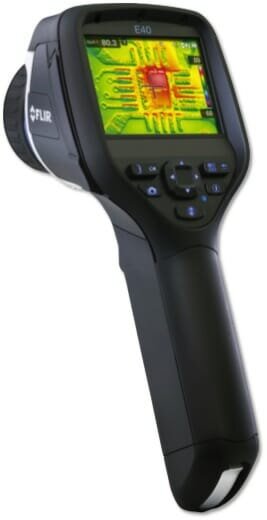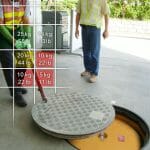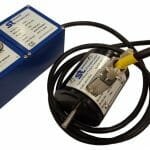For measuring temperature is it best to use a spot thermometer, a thermal imaging camera or a combination of the two? Well essentially it depends on the job, whether you simply want to confirm temperature or investigate a wider problem. Another consideration is value for money. Are you best served by a basic device or one whose cost can be justified across a variety of tasks?
All the devices work according to the same principle; they are non-contact devices that detect infrared radiation and translate it into a temperature reading. Indeed a spot thermometer can be seen as a thermal camera with just one pixel and it can be very useful for a wide variety of tasks. But, it is still simply a tool that measures temperature in one spot, nothing else. This may be sufficient for some jobs but it does not allow the full potential of thermal measurement to be incorporated into your working life.
Multiple measurement points
Whilst a spot thermometer gives you a single number, a thermal imaging camera generates an image from multiple pixels each of which provides a temperature reading. In effect the camera combines thousands of spot thermometers in one device. So a camera with an image resolution of 160 x 120 pixels, such as the FLIR E40, is therefore able to provide 19,200 temperature readings at once.
These many thousands of measurement points are then translated into a thermal image embedded with temperature data, providing a complete overview of the target area. This allows you to see the thermal profile of the problem and its heat distribution. It puts the hot spot into context, greatly assisting diagnosis. Some cameras also provide a simultaneous visual image and cleverly combine both thermal and visual images to give greater detail.
A thermal camera also saves inspection time. Scanning large areas with many components using a spot thermometer is a very time consuming task whereas, with a camera, a single image is often all that is needed. Also, thanks to their advanced optics, thermal cameras can resolve temperatures from further away and with a greater degree of accuracy.
By comparison, for a spot thermometer to maintain its accuracy, very close attention must be paid to its spot size in relation to the size of the target; the smaller the target, the closer the camera needs to be to that target to ensure the spot size covers it entirely. If the target is smaller than the spot size, the detector will take in infrared radiation from the object’s surroundings, potentially compromising accuracy.
Multiple applications
So how can a thermal imaging camera benefit your work as a professional electrician? A small point-and-shoot model is ideal for inspecting low voltage installations. The technology can quickly locate hot spots, determine the severity of the problem and help establish a time frame in which the equipment should be repaired.
Corroded or poor connections, internal fuse damage and internal circuit breaker faults will all show up as hotspots on a thermal image you can see how they relate to one another. And most importantly this knowledge allows you to act appropriately to prevent costly damage and to avoid any danger of fire.
Thermal imaging is also widely used for the inspection of high voltage installations and for detailed problem analysis but in order to conduct this work you will need a higher range camera. Indeed, there are two key factors when considering the best camera to detect electrical faults; clarity of image and operation safety.
Both are best served by a model with a minimum resolution of 320 x 240 pixels. This gives an adequate number of measurement points to allow you to see important details at a greater distance away from the target.
What’s new?
Recent developments have taken the scope of temperature measurement even further. Electricians no longer have to choose between a spot thermometer and a thermal imaging camera, they now also have the option of an imaging thermometer. The development of a micro thermal imaging core has allowed the benefits of spot measurement and radiometric imaging to be combined so electricians can have both technologies instantly available for fast and effective troubleshooting.
Indeed, the introduction of the micro-core is paving the way for a range of combined technologies, so watch this space! In the meantime we have a FLIR TG165 to give away. This is the latest generation imaging thermometer that lets you see heat patterns, measure temperatures accurately and store management data for reporting.








